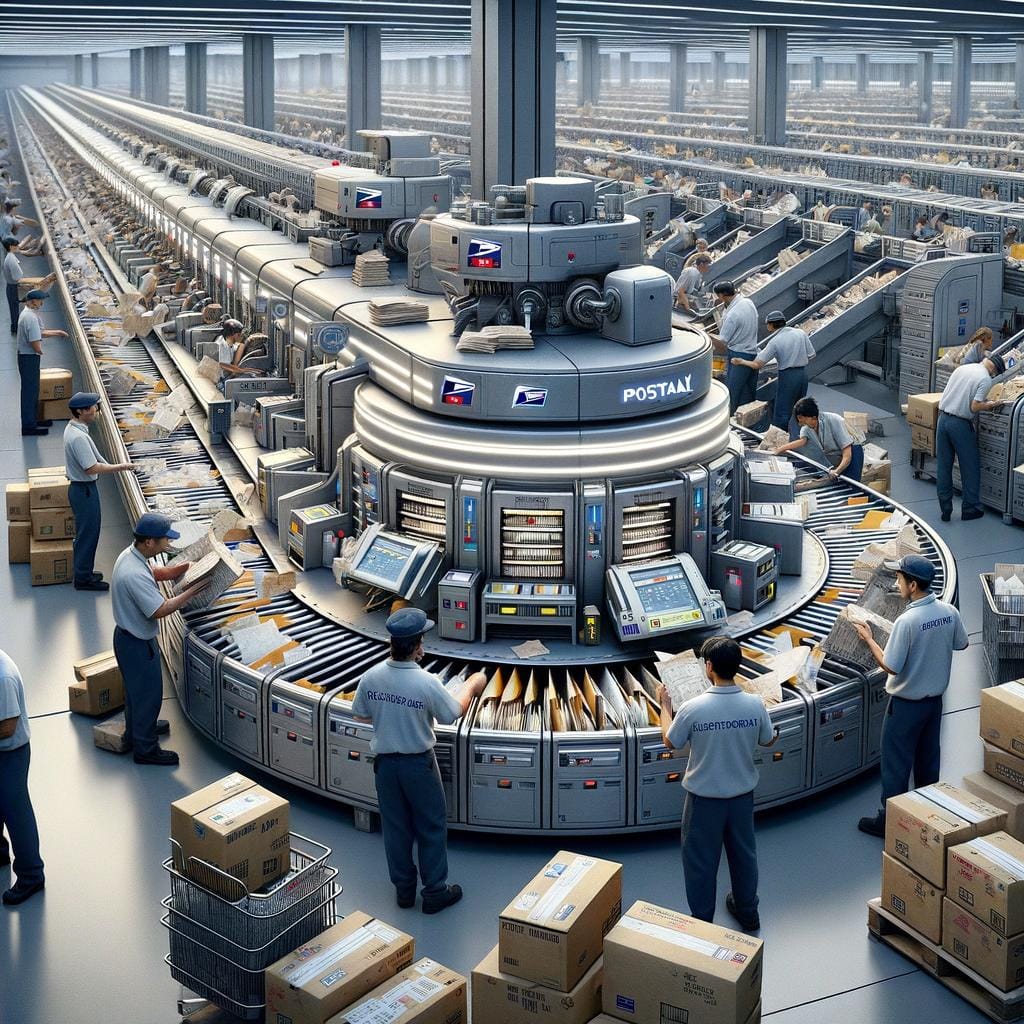Mail sorting systems play a crucial role in efficiently managing the influx of mail in businesses, organizations, and postal services. These systems have revolutionized the way mail is processed, sorted, and delivered, saving time and improving accuracy. From manual sorting methods to modern automated solutions, the evolution of mail sorting technology has been remarkable.
In the past, mail sorting was a labor-intensive task that relied heavily on human effort and manual processes. With the advent of technology, businesses began to adopt automated mail sorting systems to streamline operations and enhance productivity. Today, sophisticated machines equipped with advanced features such as optical character recognition and barcode sorting are used to handle large volumes of mail swiftly and accurately.
Implementing a mail sorting system in businesses comes with a myriad of benefits. Not only does it significantly reduce processing time and errors, but it also improves overall efficiency in handling incoming and outgoing mail. By investing in a reliable mail sorting system, companies can ensure timely delivery of important documents, invoices, packages, and correspondence to their intended recipients.
History of Mail Sorting
The history of mail sorting systems is a fascinating journey that showcases the evolution of technology and its impact on efficiency in handling large volumes of mail. In the past, before automated systems were implemented, mail sorting was a labor-intensive process that relied heavily on manual labor. Sorting centers would have teams of workers manually organizing letters and packages based on destination, which was not only time-consuming but also prone to errors.
With the advancement of technology, particularly in the late 20th century, the introduction of automated mail sorting systems revolutionized the way mail is processed. Automated systems utilize various technologies such as Optical Character Recognition (OCR) and barcode sorting to quickly and accurately sort incoming mail based on predetermined criteria. This transition from manual to automated systems significantly increased the speed and accuracy of mail sorting, allowing businesses and postal services to handle larger volumes with greater efficiency.
The implementation of automated mail sorting systems has brought about numerous benefits, including reduced costs, faster processing times, improved accuracy, and enhanced tracking capabilities. Businesses that rely on timely delivery of mail can greatly benefit from investing in these systems. As technology continues to advance, we can expect further innovations in mail sorting technology that will continue to streamline processes and improve overall efficiency in mail management.
| Benefits | Description |
|---|---|
| Reduced Costs | Automated systems lower labor costs associated with manual sorting. |
| Faster Processing Times | Automation speeds up the sorting process, leading to quicker delivery times. |
| Improved Accuracy | Automated systems minimize errors compared to manual sorting methods. |
Benefits of Implementing a Mail Sorting System in Businesses
Utilizing a mail sorting system in businesses can provide a myriad of benefits, enhancing efficiency and optimizing operations. Here are some key advantages:
1. Time-saving: Implementing a mail sorting system can significantly reduce the time spent on manual sorting processes. With automated systems in place, letters and packages can be sorted and distributed swiftly, saving valuable time for employees to focus on other tasks.
2. Cost-effectiveness: By streamlining the mail handling process, businesses can cut down on labor costs associated with manual sorting. This can lead to significant savings over time, making the initial investment in a mail sorting system well worth it.
3. Enhanced accuracy: Manual sorting can sometimes lead to errors or misplacements of important documents or packages. A mail sorting system ensures accurate distribution, reducing the risk of lost or misplaced items. This not only improves efficiency but also enhances customer satisfaction by ensuring timely delivery of mail.
Types of Mail Sorting Systems
When it comes to mail sorting systems, two main technologies have emerged as the frontrunners: Optical Character Recognition (OCR) and Barcode Sorting. These systems have revolutionized the way businesses handle incoming and outgoing mail, increasing efficiency and accuracy in the process.
Optical Character Recognition (OCR) technology uses advanced algorithms to scan and recognize text on envelopes or labels. This allows for automated sorting based on the address information printed on the mail piece. On the other hand, Barcode Sorting utilizes barcodes that are printed on mail items to facilitate quick and accurate sorting through scanning processes.
Both OCR and Barcode Sorting systems offer their own unique advantages. OCR is capable of reading handwritten addresses, making it versatile for a wide range of mail items. On the other hand, Barcode Sorting provides a fast and reliable method of sorting mail based on standardized barcode information.
| Optical Character Recognition | Barcode Sorting |
|---|---|
| Capable of reading handwritten addresses | Relies on standardized barcode information |
| Offers versatility for different types of mail items | Provides fast and reliable sorting process |
| Advanced algorithms analyze text for accurate sorting | Uses scanning processes for quick identification |
How Does a Mail Sorting System Work?
A mail sorting system is an essential tool for businesses and organizations that handle large volumes of mail on a daily basis. These systems help streamline the process of sorting, organizing, and delivering mail efficiently. Understanding how a mail sorting system works can provide valuable insights into its benefits and functionalities.
Here are some key steps in the process of how a mail sorting system works:
- Collection: The first step involves collecting all incoming mail from various sources, such as postal services or internal departments.
- Sorting: Once the mail is collected, it is sorted based on predetermined criteria, such as destination, department, or recipient.
- Identification: Through technologies like Optical Character Recognition (OCR) or barcode scanning, the system reads and identifies addresses or specific codes on the mail pieces.
- Routing: After identification, the system routes each piece of mail to the designated location within the organization for further processing or delivery.
By automating these steps through a mail sorting system, businesses can significantly increase efficiency, reduce errors, and improve overall productivity in handling incoming mail. The utilization of advanced technologies has revolutionized traditional manual sorting processes into fast and accurate automated systems.
Moreover, implementing a reliable mail sorting system can lead to cost savings by optimizing labor resources and reducing delivery times. With customizable features tailored to specific business needs, organizations can enhance their overall workflow and ensure timely and accurate delivery of important documents and packages. Embracing modern mail sorting technology is crucial in today’s fast-paced business environment to stay competitive and maintain high levels of customer satisfaction.
Top Features to Look for in a Mail Sorting System
When investing in a mail sorting system for your business, it is essential to consider key features that will enhance the efficiency and accuracy of your mail processing operations. Here are some top features to look for in a mail sorting system:
Speed and Accuracy
One of the most crucial features to consider in a mail sorting system is its speed and accuracy. A high-speed system that can process a large volume of mail quickly while maintaining accuracy is vital for improving productivity and reducing errors in the sorting process. Look for systems that are equipped with advanced technology such as optical character recognition (OCR) to ensure fast and precise sorting.
Flexibility and Scalability
A good mail sorting system should be flexible enough to handle various types of mail, including letters, packages, and parcels of different sizes. It should also be scalable to accommodate the growth of your business and adapt to changing mail processing needs. An ideal system should allow for easy upgrades and expansions as your business expands.
Integration With Other Systems
Another important feature to look for in a mail sorting system is its ability to integrate seamlessly with other systems within your organization, such as customer relationship management (CRM) software or inventory management systems. This integration can streamline workflow processes, improve communication between departments, and enhance overall operational efficiency. Choose a system that offers compatible interfaces and APIs for easy integration with existing software platforms.
By considering these key features when selecting a mail sorting system for your business, you can optimize your mail processing operations, increase productivity, reduce manual errors, and ultimately improve customer satisfaction through timely and accurate delivery of mail items. Investing in a reliable and efficient mail sorting system is a strategic decision that can have a significant impact on the overall efficiency of your business operations”.
Case Studies
In the fast-paced world of business, efficient mail management is essential for maintaining communication with customers and partners. Implementing a mail sorting system can streamline the process of sorting and distributing mail within a company, saving time and increasing productivity. Let’s explore some case studies where companies successfully implemented mail sorting systems to improve their operations.
Company A: Streamlining Operations With Barcode Sorting
Company A, a large corporation with multiple branches across the country, was struggling to efficiently manage incoming mail. They decided to invest in a state-of-the-art mail sorting system that utilized barcode technology to automate the sorting process.
By scanning barcodes on envelopes, the system could accurately allocate mail to the appropriate departments or individuals within the company. This not only reduced errors in handling but also significantly decreased processing time, allowing employees to focus on more critical tasks.
Company B: Enhancing Accuracy With Optical Character Recognition
On the other hand, Company B, a mid-sized organization heavily reliant on customer correspondence, sought to enhance accuracy in their mail sorting process. They opted for a mail sorting system equipped with Optical Character Recognition (OCR) technology, which could accurately read and interpret addresses on envelopes.
This enabled Company B to significantly reduce misrouted mail and improve delivery times. Moreover, OCR technology allowed for customized sorting rules based on specific criteria set by the company, ensuring precise distribution of incoming mail.
Company C: Improving Customer Service With Mail Tracking
Lastly, Company C recognized the importance of providing excellent customer service through prompt responses to inquiries and requests. By investing in a high-tech mail sorting system that incorporated mail tracking capabilities, they were able to monitor the status of each piece of incoming or outgoing mail in real-time. This not only improved efficiency in handling customer queries related to postal deliveries but also enhanced their overall brand reputation for reliability and responsiveness.
These case studies highlight how different businesses have successfully implemented various types of mail sorting systems tailored to their specific needs and objectives. Choosing an appropriate system that aligns with your company’s requirements can lead to significant improvements in operational efficiency and customer satisfaction.
Future Trends in Mail Sorting Technology
As technology continues to advance at a rapid pace, the future of mail sorting systems is being shaped by the integration of artificial intelligence (AI) and machine learning. These cutting-edge technologies hold the promise of revolutionizing traditional mail sorting processes by improving accuracy, efficiency, and speed. By incorporating AI and machine learning into mail sorting systems, businesses can expect to experience a whole new level of automation and optimization in their mail management operations.
One of the key advantages of integrating AI and machine learning into mail sorting systems is the ability to enhance decision-making capabilities. With AI algorithms analyzing data in real-time, these systems can quickly adapt to changing circumstances and make intelligent choices when sorting mail items.
This not only improves accuracy but also helps streamline the entire sorting process, saving time and reducing errors. Additionally, machine learning algorithms can continuously learn from patterns in mail items, further increasing efficiency over time.
Furthermore, AI and machine learning integration in mail sorting systems provide opportunities for predictive maintenance and proactive troubleshooting. By monitoring system performance and identifying potential issues before they occur, businesses can minimize downtime and ensure continuous operation of their mail sorting system.
This proactive approach not only improves overall reliability but also reduces maintenance costs in the long run. Overall, investing in AI and machine learning integration for mail sorting technology is a strategic move for businesses looking to stay ahead in an increasingly digital world.
Conclusion
Investing in a mail sorting system is crucial for businesses looking to streamline their mail management processes and improve efficiency. As discussed in this article, the history of mail sorting has evolved from manual systems to advanced automated technologies, making it easier for companies to handle large volumes of incoming and outgoing mail. By implementing a reliable mail sorting system, organizations can benefit from increased accuracy, faster processing times, and reduced operational costs.
One of the key advantages of using a mail sorting system is the ability to accurately sort and distribute mail based on pre-defined criteria such as postal codes or addresses. This level of precision not only saves time but also minimizes errors that can occur with manual sorting methods. Additionally, with advancements in technology such as optical character recognition and barcode sorting, businesses have more options to choose from when selecting a system that best fits their needs.
Looking ahead, future trends in mail sorting technology are leaning towards the integration of artificial intelligence and machine learning. These innovations have the potential to further enhance the speed and accuracy of mail sorting systems, ultimately leading to even greater efficiencies for businesses.
As the demand for faster and more reliable mail processing continues to grow, investing in a high-quality mail sorting system will become increasingly essential for companies seeking to stay competitive in today’s fast-paced business environment.
Frequently Asked Questions
How Does Mail Sorting Work?
Mail sorting involves the systematic categorization of incoming mail based on zip codes, addresses, or other identifying information. This process helps ensure that each piece of mail reaches its intended destination efficiently and accurately. Typically, automated machines scan the mail and route it to the appropriate location for further processing.
Is Mail Sorting a Hard Job?
Mail sorting can be a physically demanding job that requires attention to detail and the ability to work quickly and accurately. Sorting large volumes of mail within strict time constraints can be challenging, especially during peak mailing seasons or at busy post offices.
Despite the repetitive nature of the task, some individuals may find satisfaction in delivering a crucial service that keeps mail operations running smoothly.
What Is the Machine for Sorting Mail?
The machine most commonly used for sorting mail is called a letter sorting machine or optical character reader (OCR). These machines use advanced technology to read and interpret addresses on envelopes quickly and accurately.
By scanning barcodes or utilizing image recognition software, OCR machines can sort thousands of letters per hour based on specific criteria such as zip codes or street addresses. This automation significantly speeds up the sorting process and reduces human error in handling mail.

Hello, I’m April Denton, your go-to expert for all things home decluttering and organization. With over a decade of experience helping individuals transform their living spaces into serene, clutter-free sanctuaries, I am passionate about the life-changing benefits of decluttering. My journey into the world of organization began out of necessity, juggling a busy career and a bustling household. I quickly realized that a well-organized home was the key to a more balanced, stress-free life.





